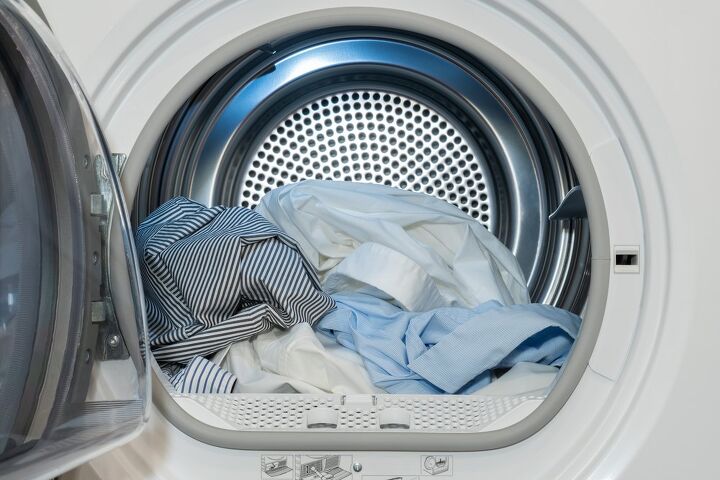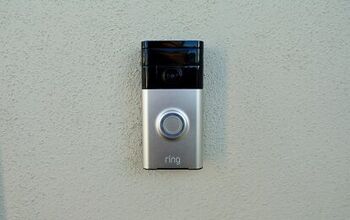Dryer Door Keeps Popping Open? (Possible Causes & Fixes)

You’re hurrying to finish yet another load of laundry. You throw the wet clothes into the dryer when, bam! The door popped back open on you, refusing to close.
If your dryer door keeps popping open, the door could be bent, or you may have worn out the strike and catch mechanisms. Opening and closing the dryer door will cause these pieces to weaken over time, or they could be dirty. Without a proper working latch, the dryer door will pop open during its cycle, so you’ll need to clean or replace it.
A washer and dryer are supposed to be a convenience in our lives and shouldn’t be a hassle to use. So, it’s time to take a deeper look at the problem. The solution to fixing this pesky dryer door may be easier than you think.
Do You Need Appliance Repair Services?
Get free, zero-commitment quotes from pro contractors near you.

Reasons For Dryer Door Popping Open
There are a few reasons a dryer door will have trouble closing. A broken latch is one common problem, but what if it’s not closing for another reason?
Worn-Out Door Latch
A common problem dryers have in time is the door latch wearing out. The catch and strike mechanisms are made of either plastic or metal. The plastic pieces are prone to breaking over time, and metal parts bend after so many uses.
If either the catch or striking mechanisms are broken, the dryer will not close. Don’t worry; this is a relatively simple fix. You can check out our step-by-step guide below for a handy how-to.
Bent Dryer Door
If the problem isn’t the catch-and-strike mechanisms. The dryer door might be bent or positioned out of place.
Look at the way the dryer door is positioned. Does the catch and strike line up as the door closes shut? If the catch and strike don’t line up, they will not connect and fail to latch the door close.
You can tighten the hinges on the frame to straighten the door. If the hinges are bent, you can use a screwdriver to straighten the hinges into place.
Be careful not to break the hinges. You’ll need to replace damaged hinges before the dryer will work again.
If the door is physically bent or damaged, you can bend it back manually as best as possible. If the damage is extensive, you may need to replace the whole door or the dryer altogether.
Lint Blockage And Debris Build Up
Lint build-up or debris blockages could also be a culprit of the dryer door popping open unexpectedly. If upon inspection of your dryers closing mechanics, you see excess lint. This can cause the door to open with little force.
Debris caught in the latch may also give the same issue. Thankfully this problem also has a simple solution.
Remove the lint or debris to allow the strike and catch to work without interference. Does your dryer seem to have a lot more lint than usual? You could have a buildup of lint in a vent or duct, limiting your dryer’s performance.
Should You Hire A Professional When Your Dryer Door Keeps Popping Open?
Hinge kits and latch assemblies are sold through the manufacturer of whatever brand of dryer you have. They range in price from $5 to $25 depending on the make of the dryer.
Replacing a latch and hinge is a simple process. Homeowners can easily take on the project themselves.
However, if you’re not mechanically inclined, the cost could potentially be covered under your warranty. An electrician or mechanic may also fix the dryer for a reasonable fee.
Deciding What To Fix When The Dryer Door Doesn’t Stay Closed
You’ve looked at the dryer… a lot. So, what’s the diagnosis, doc?
Is the dryer door slightly crooked? Is the latch not catching, or is there a bent hinge? Or, is it something else entirely?
Determining what to replace allows you to know exactly where to start when fixing the problem. If there is a bent hinge, you can try bending it back using a tool. Or you can replace the hinges altogether.
If the latch isn’t catching, you may need to replace the strike or catch. Closely examining what happens with these two mechanisms will determine if you need one or both components.
When closing the dryer, does it easily snap close with the clicking noise? Then open the dryer to see how easily the dryer opens in comparison to closing. You should be able to decide if one is weaker than the other or if both are worn.
How To Replace The Catch-And-Strike
Think you can fix the problem yourself? If you’re even a little handy, have confidence you can tackle this project.
Replacing the catch-and-strike is simple. Follow the instructions below to find out how it’s done.
Tools You Need For The Job
- Phillips screwdriver
- Pair of needle-nose pliers
- Replacement catch and strike mechanisms
Step One: Remove The Dryer Door
Open the dryer door and access the hinge screws. Detach the hinge screws and remove the door from the rest of the dryer.
Step Two: Remove The Door Catch
Remove all screws around the edge of the dryer door. After removing these, you can separate the inner door panel from the back of the dryer door to expose the door catch.
Using needle-nose pliers, pinch the metal on both sides of the catch. Wiggle the catch out of the door panel.
Step Three: Install The New Door Catch
After removing the catch, replace it with the new one. You can then reattach the inner dryer door panel back to the outer door panel. The door is now ready to reattach back to the dryer unit (but don’t do so yet).
Step Four: Replace The Strike
Where the door typically catches too close, grab the strike with needle-nose pliers. Pinch the strike and wiggle it free from the unit. Snap the new strike in to replace the old one.
Step Five: Reattach The Dryer Door
Reattach the dryer door using the hinge screws, and test out your handiwork.
Other Tips For Other Models Of Dryers
The catch and strike mechanisms may be reversed depending on the type of dryer you have. If your dryer’s mechanisms are flipped, you will have access to the metal bracket. The metal bracket behind the catch is what’s attaching it to the unit. Use needle-nose pliers to remove the catch.
If you have a dryer with a glass front, you will not need to remove the dryer door from the rest of the unit. Instead, simply remove the screws from the edges of the door. This will separate the front panel from the back panel and allow you to access the catch.
Alternative Fixes To Your Dryer Door Popping Open
What if buying a new dryer isn’t an option, and hiring a professional would break the bank right now? These options might not be the most stylish or classy, but they’ll keep the door shut long enough to dry your clothes.
Here are a few alternative options to keeping that pesky dryer door shut.
Use Magnets
Use adhesive to attach magnets to the inside of your dryer door and the frame around where the door closes. Place the magnets so they will line up and stick together when closing the door.
This method was suggested by many people struggling with the same issue. The method proves to be both effective and budget-friendly.
Try Some Tape
When all else fails, duct tape is the answer. Take a strip and wrap it around the front of your dryer. This will prevent the door from popping open.
You probably had duct tape lying around somewhere, and now the dryer will stay closed. Unfortunately, this may leave behind a sticky residue from the tape.
Use Bungee Cords
This suggestion popped up more times than you would think. Use two bungee cords wrapped around the dryer to keep the door closed.
It’s a pretty good idea and looks better than tape. Plus, it won’t leave behind sticky goo.
Use Hook and Loop Fasteners
Attach hook-and-loops with adhesive to the top and bottom corners of the dryer door. This will work like the magnets. Instead of using magnetic attraction, these hooks will fasten when the door is closed and keep it from popping open.
Do You Need Appliance Repair Services?
Get free, zero-commitment quotes from pro contractors near you.

Related Questions
Can a dryer cause a fire?
A clog in a vent, duct, or filter are the most common reasons a dryer fire happens. To minimize the risk of a dryer fire, you should always make sure to clean the dryer filter before running it. The typical recommendation is to have your dryer vent cleaned at least once a year.
Why does my dryer start then stop?
There are several reasons a dryer may start and then suddenly stop. Pay attention to surrounding factors to figure out what made the dryer stop.You could have a clogged exhaust vent. The dryer door catch could be loose, or the switch is bad. Even worse, the dryer’s motor relay could be acting up.If there is a mechanical issue with the dryer, it could be overheating and setting off the thermal switch. This switch automatically turns the dryer off when it begins to overheat.
What maintenance should I regularly do on a dryer?
Preventative maintenance is extremely important when it comes to the laundry room. Doing regular maintenance can protect your home from a potential fire. You can start by cleaning the lint trap in your dryer before every use. This is probably something you’ve done before, but did you know there’s more lint elsewhere?At the back of your dryer, there is a tube attached called a lint tube. This tube runs into the dryer duct, which leads outside of the home. You should clean this tube and vent at least once a year.Homeowners can pay a professional to come clean the vent, or they can do it themselves. You can clean this vent using a vacuum or brush-like item that you can feed through the duct. Some people have used leaf blowers, but it’s unclear how effective this method is. Cleaning the vents and ductwork will prevent your laundry room from becoming a fire hazard in the future.

Stacy Randall is a wife, mother, and freelance writer from NOLA that has always had a love for DIY projects, home organization, and making spaces beautiful. Together with her husband, she has been spending the last several years lovingly renovating her grandparent's former home, making it their own and learning a lot about life along the way.
More by Stacy Randall



























